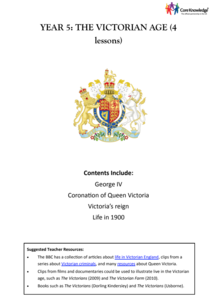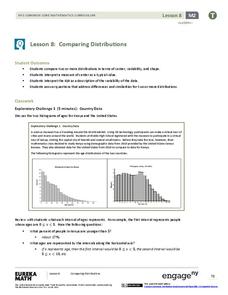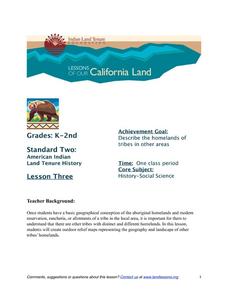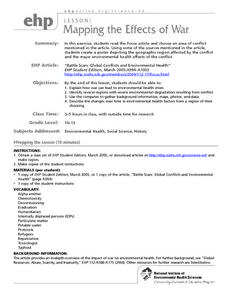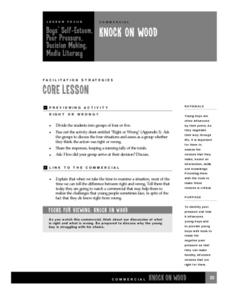Curated OER
8th Grade Reading Comprehension Success
Augment your eighth grade language arts curriculum with a thorough set of reading comprehension activities and assessments. Focusing on a variety of skills, including vocabulary in context, text structure, main idea, and author's style,...
Core Knowledge Foundation
The Victorian Age
The length of Queen Victoria's reign, surpassed only by Queen Elizabeth II in the modern era, stretched through much of the 19th century and into the 20th century. Explore the many social, industrial, and political shifts that occurred...
Geophysical Institute
Latitude and Longitude with Google Earth
Travel the world from the comfort of your classroom with a lesson that features Google Earth. High schoolers follow a series of steps to locate places all over the earth with sets of coordinates. Additionally, they measure the distance...
EngageNY
Comparing Distributions
Data distributions can be compared in terms of center, variability, and shape. Two exploratory challenges present data in two different displays to compare. The displays of histograms and box plots require different comparisons based...
DiscoverE
Product Dissection
Sometimes, taking things apart is more fun than putting things together. Groups of learners participate in a reverse engineering activity. They dissect a device of their choosing to see how it works—great hands-on learning from the...
ELA Common Core Lesson Plans
American Romanticism
Nathaniel Hawthorne's "Rappaccini's Daughter" provides the text for an activity that asks readers to select specific passages from the story, identify the aspect of American Romanticism the passage exemplifies, and then provide an...
Santillana USA
Celebra Kwanzaa
¡Celebramos Kwanzaa! Celebrate Kwanzaa through the fictional story Celebra Kwanzaa con Botitas y sus gatitos to delightfully explain the seven principles of Kwanzaa. Dual language learners participate in reading and vocabulary...
Indian Land Tenure Foundation
More Tribal Homelands
Here is a very fun idea that introduces young learners to how geographical location affects cultural development. They are introduced to four areas where Native Americans have lived in the past by reading stories and examining images....
DiscoverE
Pilot a Balloon
Balloons will go where you want them to. Young pilots first add paper clips to a balloon to make it neutrally buoyant. They then use cardboard to steer the balloon in different directions, taking air pressure into account.
Curated OER
Catch Your Breath
Seventh graders explore the structure, function, and diseases of the respiratory system. They research basic information about the respiratory system and create a concept map to illustrate it. Students research a disease and create a...
Curated OER
The Fault Line
Students use cardboard models of the North American and Pacific plates and sand to investigate what happens when there is an earthquake or movement along the boundaries of the plates.
Curated OER
Mapping the Effects of War
Students examine how war can lead to environmental health crises. They read an article, conduct research on a region from the article, and create a poster to depict the geographic region and the environmental health effects of the conflict.
Curated OER
Using a Thermometer
First graders use their senses to formulate questions and make predictions to determine what is in the "Wonder Bag". They hold pieces of ice and examine while listing descriptors on a chart and then take their own temperature using an...
Curated OER
Moon Phases
Students engage in a study looking for the differences found during the cycle of one lunar month. They conduct research using a variety of resources. Then the information is used to construct a lunar calendar to observe daily changes and...
Curated OER
Sun and Temperatures
Learners consider the relationship of temperature to environmental conditions and then apply their knowledge to a practical event. The task assesses students' knowledge and application of that knowledge to an additional situation.
Curated OER
What Can a Leaf Be?
Students identify leaves for an art project and create a collage. For this leaf lesson, students review leaf characteristics. Students use leaves to create a collage of an animal or creature. Students write recipes of leaves for their...
Curated OER
Night Sky
Students discover why stars can only be seen at night. They participate in a read aloud of, "Night Sky" by Carole Stott and, "Switch on the Night" by Ray Bradbury. Using the sky objects described in the readings, they brainstorm and list...
Curated OER
A Crust Full of Rocks
In this rock worksheet, students answer seven short answer questions about the composition of the earth's crust. Questions refer to metamorphic, igneous, and sedimentary rocks.
Curated OER
Height of Bounce
Eighth graders determine the relationship between the height of bounce of a ping-pong ball and the height from which it was dropped. They are assessed on the ability to record and interpret data, graph data, make predictions, and make...
Curated OER
Your Own Fresh Water Aquarium in the Classroom
Learners explore aquariums. In this fish and ecosystems lessons, students establish a freshwater aquarium environment using materials provided. Learners read about and care for the classroom fish.
Curated OER
Knock On Wood
Learners investigate the trees of the Mississippi Valley, specifically looking at the coniferous and deciduous forests. The research of the area is part of a field study when students conduct a survey of local forests in order to create...
Curated OER
Oil Spill
Pupils use one of four absorbent products to separate as much of the oil and water mixture they are able to do. The purpose of this task is for students to collect and analyze data for the purpose of determining which absorbent is best,...
Curated OER
Marine Animal and Plant Adaptations
Students examine nature by creating their own animals. In this animal adaptation instructional activity, students define scientific vocabulary terms dealing with adaptation such as sea stars, sea cucumbers and exoskeleton. Students...
Curated OER
Hydrolysis
In this hydrolysis worksheet, students write dissociation equations for the given salts and determine if the salt is acidic, basic, or neutral. This worksheet has 6 fill in the blank questions and 4 problems to solve.
Other popular searches
- 5 E Science Magnets
- 5 E Science Lessons
- 5 E Science Forces
- Science 5 E Model
- Science 5 E
- Life Science 5 E
- Science 5 E Model
- 5 E Science Lesson Plans
- 5 E Model Science Lessons
- Physical Science 5 E
- 5 E Science Flowers

